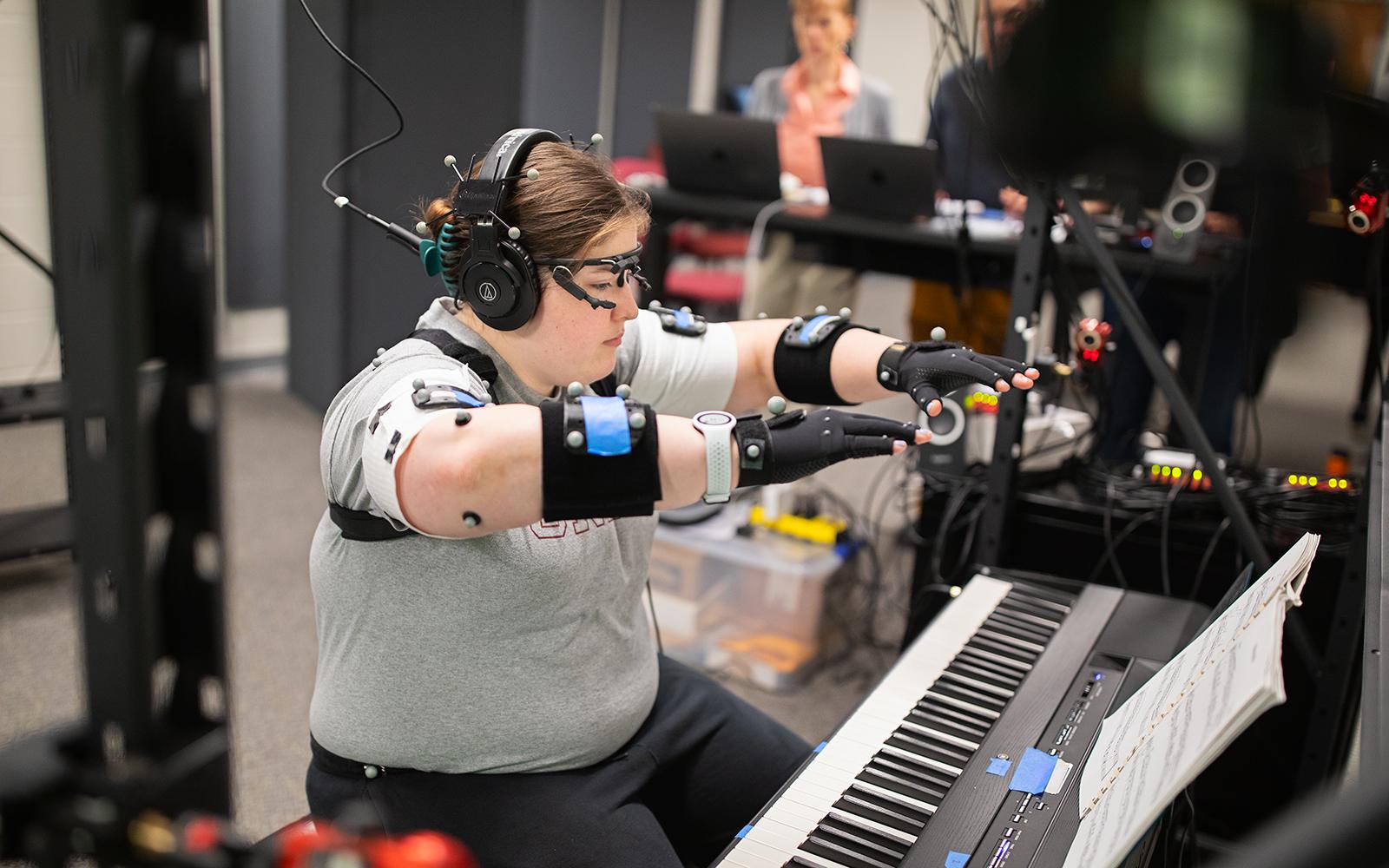Surrounded by an array of 23 infrared cameras, Ryan Dunia ’26 plays his saxophone with more than 40 reflective markers attached to his clothing, gloves and a headband—part of an elaborate motion capture study being conducted by Assistant Professor Tracy Lipke-Perry at The Crane School of Music focused on musicians’ health.
“We’re reconstructing a 3D model of each participant, so that we can analyze their movements without them there, within millimeters and less, so very precise in terms of posture and ergonomics. We can look at the angles, but we can also talk about total movement. We can be specific about one joint or complete movement,” Lipke-Perry explained.
“Having this space really makes it feasible to integrate the entire campus, reach more students, and forge ahead toward this campus being a leader in performance science nationally.”
Working inside the newly renovated CHIRPS (Center for Health, Interdisciplinary Research, and Performance Science) lab at Crane, Lipke-Perry is capturing a plethora of data on musicians and their movement. One saxophonist, one bassoonist and 20 keyboardists are being studied this semester with advanced infrared 3D reconstruction—data that is being used to address pain and discomfort, and provide feedback about improving posture.
Dunia, a music education major at Crane who also performs with the Symphonic Band, was excited to join the study to carefully analyze his body movement as he deals with increased neck and back pain while playing the sax. “It was funny to put the whole suit on at first. I felt like I was going to be in the new Avatar movie. It’s a very cool study and we’re very fortunate to have this at the school,” he said.
Sitting versus standing and playing the saxophone with a strap versus a harness, were all variables that changed as Lipke-Perry collected data for the study. Even before the data was fully analyzed, Dunia already had a sense of how to improve his posture to avoid pain and discomfort in the future. “That’s probably the biggest thing that I got out of this, was learning what I need to do while playing, and how to have better posture,” he said.
Lipke-Perry’s motion capture study with keyboard musicians was even more extensive, as she compared sophomore-level musicians with professional keyboardists, to see if experience has an effect on posture and ergonomics. Directed to play under different conditions (ranging from being internally focused on their fingertips, to externally focused on an abstract idea associated with the song they were playing) the keyboardists’ movements were tracked based on their thought process.

“This has been well studied in sports. For example, if you’re shooting free throws, is it better to pay attention to your wrist or your knees, which is internal, or something like the rim,” she said. “We already have several studies published that show external performs better than internal, but now the difference is adding the professional musicians to this, having that comparison population to see if there’s a difference.”
The motion capture study also collected a broad range of data points like eye tracking and pupil dilation, the latter of which provides data on stress and mental acuity. “We’re looking at their cognitive load in response to what we’re asking them, which is also new ground,” she said.
The new lab, which was overhauled during the summer of 2023 with the help of Roy Smith, David Kingsley and SUNY Potsdam’s Physical Plant staff, included the installation of a large metal framework that allows the 23 cameras to be clamped around the musicians as they play. Smith and Kingley also installed sound-dampening panels that improve the acoustics within the room. “The idea for this is to be a performance science hub on this campus and to lead, particularly musician health, nationally in that regard,” she said. “Overall, this lab is about improving practice and performance for musicians. That’s the mental and physical components.”
Lipke-Perry also secured more than $16,000 in grant funding from the Lougheed Center for Applied Learning to support the research project with her students. Thinking about the new lab from an interdisciplinary standpoint, she worked on a piano study in the Spring of 2022 with Emily Vierno ’22, an exercise science major who is now pursuing master’s degree at Clarkson University. Their research, “Development of Photogrammetry Techniques to Investigate Musicians’ Posture,” won the top spot for the Frederick B. Kilmer Research Award during the College’s annual Learning & Research Fair.
Now, as she works on a new research project with 15 students from her Functional Keyboard class, and five professional musicians, she’s gathering more data points than ever before, and trying to address issues surrounding musicians’ health.
“Part of the impetus for this research was the comments that I was getting from my students. They were telling me that they had pain in their hand, so trying to facilitate healthy posture and ergonomics before it becomes something chronic. I’ve had students down the road who have had surgery, so I’m trying to take a much more proactive approach with them, and be a hub for that here,” she said. “Having this space really makes it feasible to integrate the entire campus, reach more students, and forge ahead toward this campus being a leader in performance science nationally.”
Article and photos by Jason Hunter
